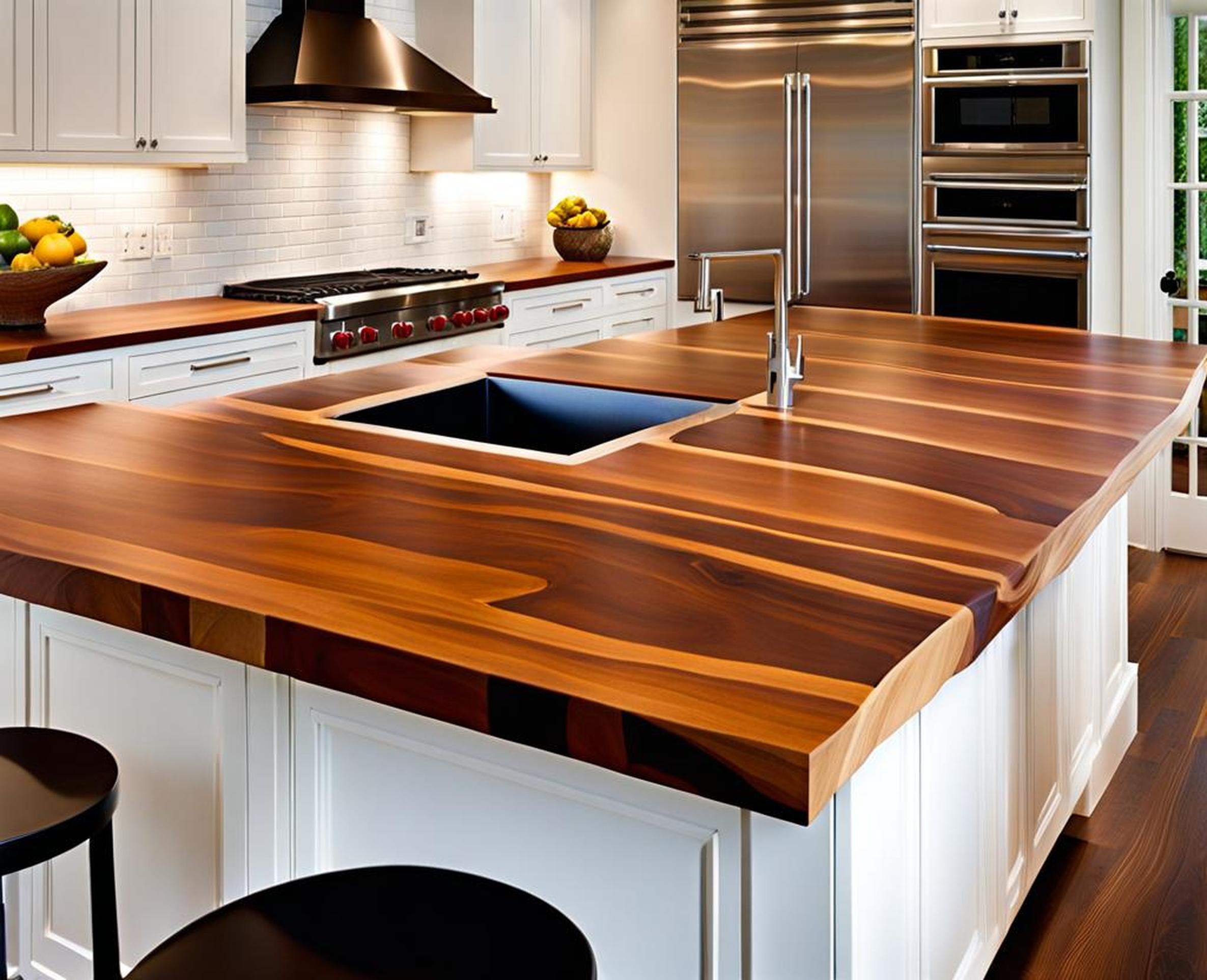Imagine stepping into a kitchen with warm, organic wood countertops welcoming you home. The rich tones and unique grain patterns reflect your personal style. Wood counters transform plain cabinetry into a breathtaking focal point that feels both elegant and timeless.
Wood countertops allow you to put your own stamp on your kitchen. With an array of species, finishes, and edge profiles, they offer countless ways to customize your space. Let’s explore why wood makes a romantic yet practical choice.
Types of Wood Countertops
You can select wood counters made from traditional maple or oak, or opt for more exotic species:

- Maple: Affordable, super hard, ages well from use
- Oak: Durable, water-resistant, rustic charm
- Walnut: Dense and resistant to dents, ages to chocolate hues
- Cherry: Develops a rich, reddish patina when finished
- Hickory: Extremely hard and suitable for busy kitchens
- Teak: Expensive but moisture-resistant and gorgeous golden color
- Zebrawood: Stunning contrasting stripe pattern for dramatic flair
- Bamboo: Sustainable and very durable, resists moisture
For a unique look, reclaimed or salvaged wood makes a gorgeous sustainable choice. Old barn boards, wine barrels, or fencing can be milled into custom counters with unparalleled character.
No two wood slabs are the same. The natural knots, whorls and color variations showcase the wood’s inherent beauty. Grain patterns range from straight and uniform to flowing waves and wild figuring. Contrasting heartwood and sapwood also add visual interest.
While no wood is totally impervious to water, some types like teak, ipe, and bamboo resist moisture well. Research how different species hold up over years of use.
Customization Options
Beyond choosing the wood itself, custom edging and built-ins let you tailor your counters. Consider these design options:
- Edge Profiles: Square, eased, beveled, or bullnose edges
- Built-Ins: Drain grooves, trivets, cutting boards, roll-out trays
- Specialty Styles: Bookmatched, parquet, mixed woods, live edge
- Finishes: Natural oils, waxes, stains from black to whitewash
Distressed finishes make new counters look antiqued. Coordinating your cabinets, floors and backsplash creates a harmonious look. Don’t be afraid to get creative!
Measuring and Planning
Careful planning ensures your dream counters fit perfectly. Consider:
- Overall countertop dimensions
- Allowance for backsplash and overhang
- Cabinet opening sizes
- Blueprints and scale drawings
- Hiring an experienced contractor
Take detailed measurements and have an installation professional evaluate your space. Many factors impact the design, including awkward angles, corners, and built-in appliances.
Installation Process
Proper installation prevents leaks, cracking, and alignment issues down the road. The process involves:
- Prepping and leveling the cabinetry
- Dry fitting counter slabs and making any adjustments
- Joining multiple boards together seamlessly
- Attaching the countertops to cabinets with brackets or adhesives
- Sealing edges with waterproof wood filler
Hiring a contractor is recommended, as they have specialized tools and expertise. But for simple DIY installs, have lumber pre-cut and watch tutorial videos.
Initial Sealing and Protection
Sealing is crucial to prevent moisture damage and bacteria growth in the porous wood. Options include:
- Oils: Penetrate deep, require frequent reapplication
- Waxes: Form protective coating, buff to sheen
- Varnishes: Durable but can yellow over time
Apply at least 3-5 coats initially, allowing proper drying time between. Repeat monthly or as needed. Proper sealing is vital before exposing wood to spills and humidity.
Ongoing Care and Maintenance
Consistent care preserves beauty and prevents issues:
- Clean daily with mild soap and water
- Re-apply sealant every 4 weeks minimum
- Promptly dry any spills or standing water
- Sand out stains and scratches
- Refinish every few years
With oil and wax finishes, the wood will develop a lovely patina. Refinishing becomes necessary once extensive staining or drying occurs. Address minor issues promptly to avoid costly repairs.
Cost Breakdown
The price of your counters depends on:
- Wood species and thickness
- Custom details like built-ins
- DIY vs. professional installation
- Total square footage
Expect to pay:
- $50-100 per sq. ft. for oak or maple
- $100-200 for exotic hardwoods
- +$25-50 for professional fabrication and installation
This results in a total project investment between $2,500 to $10,000+. Compare quotes to find the best value.
Inspiring Kitchen Examples
Wood counters complement any design aesthetic beautifully:
- Modern Farmhouse: White cabinets, subway tile, butcher block island
- Rustic Cabin: Knotty pine counters, stone backsplash, black accents
- Sophisticated Contemporary: Glossy cabinetry, sleek lines, exotic wood
- Eclectic Bohemian: Distressed multicolored woods, vintage accents
Stunning imagery helps ignite your own kitchen vision. Browse Pinterest and design sites for inspiration on wood species, finishes, and decor.
Wood counters offer limitless ways to customize your kitchen with natural warmth and beauty. While requiring careful prep and maintenance, they provide a classic yet on-trend look. With handy tips for planning, installation, and care, you can enjoy stunning wood counters for years to come.
Ready to upgrade your kitchen with beautiful custom wood countertops? Let our imagination run wild to create your dream space. With the right combination of wood, finish, and details, we can design the heart of your home to flawlessly match your style and needs.
